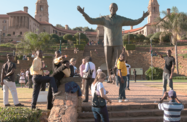While international arrivals remain a mainstay of South Africa’s tourism sector, a revision to the national tourism strategy is looking to stoke growth in the domestic travel industry.

On May 5 the Ministry of Tourism submitted a final draft of the National Tourism Sector Strategy (NTSS) for public comment over the following 60 days.
The new draft – a revised version of the original 10-year NTSS, which was first published in 2011 – maintains a focus on foreign tourism as the driving force for the industry, but places a greater emphasis on investment in the domestic segment.
Domestic slowdown
The need for the renewed focus is warranted. Domestic tourism has declined in recent years, falling short of the first NTSS’s forecast that local holiday trips would rise from 4m in 2009 to 6m by 2015. According to national marketing agency South African Tourism, the actual 2009 total was 3.6m and fell to 2.84m in 2015, with a further drop projected for last year.
The decline is attributed in part to the continued slow growth of South Africa’s economy, which is forecast to grow by just 0.8% this year, as well as a depreciating currency and low levels of job creation.
“Domestic economic conditions are the main factor contributing to lacklustre domestic tourism growth and spend, although market awareness and product offerings play some part,” the new NTSS said. “Domestic holiday numbers affect the economic impacts of tourism and, with improved domestic tourist performance, the economic impacts would have undoubtedly been more positive.”
Promotional drive at home
The revised NTSS targets an increase of around 5m tourists by 2022, one-fifth of which are projected to be domestic travellers – a goal echoed by President Jacob Zuma at an industry event in May, local media reported.
To achieve this, the ministry’s blueprint speaks of a need to promote a “culture of travel” among South Africans, a policy requiring higher levels of investment and resources at all levels of the industry. The new resources, it says, would be used for expanded marketing campaigns and for choosing and supporting priority segments.
In a step towards fostering local holidaymaking, South African Tourism recently announced it will launch an online product called “Good Times in a Box” later this year, offering a range of package vacations from family getaways to girls’ weekends, with the aim of streamlining bookings.
The hope is to make travel more accessible for domestic tourists who might otherwise consider arranging a trip too burdensome by “removing the hassle”, Sisa Ntshona, CEO of South African Tourism, told local media in May.”
“Good Times in a Box” is part of a broader programme called “I Do Tourism”, aimed at raising local awareness of tourism’s rising importance to the economy. Launched in May at the annual Indaba tourism event in Durban, the campaign aspires to change how tourism workers – from taxi drivers to hotel owners – interact with clientele, encouraging them to be more hospitable and tourist-friendly.
Growth forecasts
Despite its recent slowdown, domestic travel remains the leading contributor to the sector, accounting for 53.9% of total sales last year, according to the “Economic Impact 2017 South Africa” report released by the World Travel & Tourism Council (WTTC).
This position could reverse in the coming years, however, if the domestic segment remains flat. The WTTC has estimated that spending on domestic tourism will increase by just 1% this year, to R151.2bn ($11.6bn), with growth accelerating to an average of 1.7% over the next 10 years to reach R178.9bn ($13.7bn) by 2027.
By contrast, WTTC forecasts see foreign tourism receipts rising by 4.4% this year to R134bn ($10.3bn), before picking up to a 7.3% average in the years to 2027, when they should hit R271.3bn ($20.8bn).
Last year was a strong one for the sector in South Africa, with overseas arrivals up 13% to reach 10m, according to the Ministry of Tourism.
African markets dominate foreign arrivals, rising by 11% and making up about three-quarters of the total, other source markets also posted strong gains. Visitor numbers from China and India, two countries targeted by South Africa for their strong growth potential, increased by 38% and 22%, respectively.


